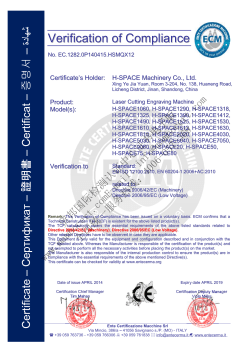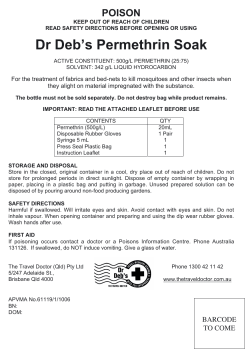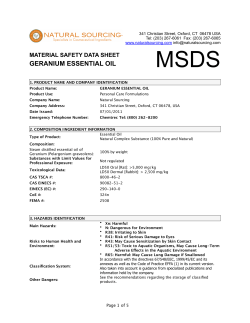
Safety Data Sheet
Safety Data Sheet NOTE: Access to a copy of this Safety Data Sheet (SDS) via our Website does not constitute the issue of a controlled Copy under EU legislation. To be issued with such a copy please contact Rentokil Initial using the details below. In order to confirm the latest version of the SDS for this product visit http://www.rentokil-initial.com/sds/ REVISION (see box 16) Issue : 10 19 : 03 : 2014 SECTION 1 Identification of the substance/mixture and of the company/undertaking. 1.1 Product identifier Woodworm Treatment HSE 3911; PCS 93092 1.2 Relevant identified uses of the substance or mixture and uses advised against An insecticidal wood preservative for amateur and professional use for the control of wood destroying insects. 1.3 Details of the supplier of the safety data sheet Rentokil Initial Supplies, Liverpool, L33 7SR, UK. Product advice line: +44 (0)151 548 5050 Emergency line: +44 (0)1342 833 022 E-mail: sds@rentokil.com National contact Rentokil Initial Supplies, Liverpool, L33 7SR, UK Product advice line: +44 (0)151 548 5050 Emergency line: +44 (0)1342 833 022 E-mail: sds@rentokil.com 1.4 Emergency telephone number 0844 892 011 (for use by medical professionals only). SECTION 2 Hazards Identification 2.1 Classification of the substance or mixture Classification according to Regulation (EC) 1272/2008. Not applicable. See section 16. Classification according to Directive 1999/45/EC (See section 16) - - Not classified. Xn Harmful R65 R66 N Dangerous for the environment. R50/53 2.2 Label elements Harmful Dangerous for the environment. WOODWORM TREATMENT SDS No. 326 - EN - GB Issue : 10 19 : 03 : 2014 Page 1 of 8 Risk phrase(s) (R), in full / Hazard statement(s) (H), in full. R50/53: Very toxic to aquatic organisms, may cause long-term adverse effects in the aquatic environment. R65: Harmful: may cause lung damage if swallowed. R66: Repeated exposure may cause skin dryness or cracking. Safety phrase(s) (S), in full / Precautionary Statement(s) (P), in full. S35: This material and its container must be disposed of in a safe way. S51: Use only in well-ventilated areas. S60: This material and its container must be disposed of as hazardous waste. S61: Avoid release to the environment. Refer to special instructions/safety data sheets. S62: If swallowed, do not induce vomiting: seek medical advice immediately and show this container or label. Contains 0.23% w/w permethrin. To avoid risks to man and the environment, comply with the instructions for use. 2.3 Other hazards Harmful if swallowed. Repeated exposure may cause skin dryness and cracking. Contains Permethrin, may produce an allergic reaction. Very toxic to aquatic organisms, may cause long-term adverse effects in the aquatic environment, however if used as directed no adverse effects are expected. SECTION 3 Composition/Information on Ingredients (See section 16) 3.2 Mixtures % w/w Common*/ Chemical Name (IUPAC) CAS No. 0.23 Permethrin*/ m-phenoxybenzyl 3-(2,2dichlorovinyl)-2,2-dimethylcyclopropanecarboxylate (cis:trans ratio 25:75) 5264553-1 >50.0 ≤100.0 Hydrocarbons, C9-C11, n-alkanes, isoalkanes, cyclics, < 2% aromatics - EC No. Index No. REACH Registration No. Directive 67/548/ EEC classification Regulation (EC) No 1272/2008 classification - Xn: R20/22 R43 N: R50/53 Acute Tox. 4 : H302 H332 Skin Sens. 1 : H317 Aquatic Acute 1 : H400 Aquatic Chronic 1 : H410 01-2119456620-43-xxxx Xn: R65 R66 Asp. Tox. 1 : H304 258-067- 613-0589 00-2 926-1416 - SECTION 4 First-Aid Measures 4.1 Description of first aid measure Inhalation Remove patient to fresh air, keep warm and at rest. Apply supportive measures if necessary and seek medical attention. Eye Contact Rinse affected eye with clean running water, or eyewash solution, for at least 15 minutes holding eyelids well apart. Rinse entire surface and do not allow run-off to contaminate unaffected eye. Seek medical attention. Skin Contact Remove and wash contaminated clothing immediately. Wash affected area thoroughly with soap and water. If the patient feels unwell seek medical advice. Ingestion (Swallowing) Do NOT induce vomiting. If unconscious place in the recovery position and apply supportive measures if necessary. If conscious give patient up to ½ litre or 1 pint of water to drink. Seek medical attention. 4.2 Most important symptoms and effects both acute and delayed (See section 2.3) Emergency Equipment Suggested Appropriate first-aid equipment should be provided. 4.3 Indication of any immediate medical attention and special treatment needed Note To Doctor Further information on all Rentokil Initial formulations is lodged with the local National Poisons Information Service. Antidote No specific antidote known. Treatment is symptomatic. WOODWORM TREATMENT SDS No. 326 - EN - GB Issue : 10 19 : 03 : 2014 Page 2 of 8 SECTION 5 Fire Fighting Measures 5.1 Extinguishing media Suitable extinguishing media Use carbon dioxide, foam or dry powder extinguishers. Unsuitable extinguishing media Do not use water jet as this may spread the fire. 5.2 Special hazards arising from the substance or mixture None, other than ordinary products of combustion. 5.3 Advice for fire fighters Wear suitable personal protective equipment. SECTION 6 Accidental Release Measures 6.1 Personal precautions, protective equipment and emergency procedures Wear suitable personal protective equipment. Remove all sources of ignition. Ensure area is well ventilated. 6.2 Environmental precautions This product is classified as dangerous for the environment. Keep away from drains, surface and ground water and soil. 6.3 Methods and material for containment and cleaning up Absorb spill with an inert material such as sand, earth or sawdust. Transfer to a suitable container for subsequent disposal. 6.4 Reference to other sections Please also see sections 8 and 13 for further information. Additional information Clear spills immediately. SECTION 7 Handling and Storage 7.1 Precautions for safe handling Wash hands thoroughly with soap and water after handling. Avoid contact with skin and eyes. 7.2 Conditions for safe storage, Store in original container in a cool, dry, ventilated place out of the reach of children and away from including any incompatibilities food, drink and animal feeding stuffs. 7.3 Specific end use(s) Wood preservative. SECTION 8 Exposure Controls/Personal Protection 8.1 Control Parameters Exposure standard - Directive 98/24/EC (1st IOELV Directive) Workplace Exposure Limit (WEL) long-term exposure (8 hour Time Weighted Average) Odourless Kerosene: (TWA 8hrs) 1200mg/m3 Workplace Exposure Limit (WEL) short-term exposure (15 minute reference period) Not applicable. Substance name used in Directive EC/98/24 (1st Not applicable. IOELV Directive) 8.2 Exposure Controls Appropriate engineering controls Where exposure may occur, engineering controls, rather than the provision of Personal Protective Equipment (PPE) should be employed. On completion of a risk assessment, the following PPE may be required: Individual Protection Measures Eye/face protection Suitable eye protection such as goggles. Hand protection Suitable hand protection such as gloves. Skin/body protection Suitable skin protection such as coveralls. Respiratory protection Avoid excessive inhalation of concentrated vapours. WOODWORM TREATMENT SDS No. 326 - EN - GB Issue : 10 19 : 03 : 2014 Page 3 of 8 Environmental Exposure Controls Use only in accordance with instructions given. Any spillage should be dealt with as a priority in order that contamination of watercourses is avoided. SECTION 9 Physical and Chemical Properties 9.1 Information on basic physical and chemical properties Appearance, odour and physical state A colourless liquid with a kerosene type odour. pH Not determined. Solubility in water Immiscible Density Not applicable. Solubility in other solvents Soluble. Relative density Not determined. Explosive properties No known explosive properties. Flash point Not determined. Combustibility Combustible. Flammability Not determined. Oxidising properties No known oxidising properties. Initial boiling Point and boiling range Isoalkane solvent: 175-213°C. Evaporation rate Isoalkane solvent: 0.040 (n-butyl acetate = 1). Vapour Density Isoalkane solvent: >1. Partition coefficient: n-octanol/water Not determined. Vapour pressure Isoalkane solvent: 0.05 kPa at 20°C. Decomposition temperature Not determined. Melting point / Freezing point Not determined. Auto-ignition temperature Not determined. Upper/lower flammability or explosive limits Isoalkane solvent: Lower explosive limit in air: 0.5% v/v. Upper explosive limit in air: 7.0% v/v. Other safety information None known. Viscosity Isoalkane solvent: 1.60 mm2/s at 25°C. 9.2 Other Information SECTION 10 Stability and Reactivity 10.1 Reactivity This product is stable under normal conditions of handling and use. 10.2 Chemical stability This product is stable under normal conditions of handling and use. 10.3 Possibility of hazardous reactions None expected under normal conditions of handling and use. 10.4 Conditions to avoid Avoid extremes of temperature, e.g. below 0°C and above 40°C. 10.5 Incompatible materials Avoid contact with strong oxidising agents. 10.6 Hazardous decomposition None, other than ordinary products of combustion. products SECTION 11 Toxicological Information (see also box 2) 11.1 Information on toxicological effects Acute Toxicity Corrosivity/ Irritation Oral LD50 (rat) >2000 mg/kg Inhalation For permethrin: LD50 (rat): >4.638 mg/l air Dermal LD50 (rat) >2000 mg/kg Skin May be irritating to skin, especially on prolonged contact Eyes May be irritating to eyes. WOODWORM TREATMENT SDS No. 326 - EN - GB Issue : 10 19 : 03 : 2014 Page 4 of 8 Sensitisation Respiratory tract May be irritating to respiratory tract. Skin Contains less than 1% skin sensitisers in the form of permethrin. Respiratory Contains no known respiratory sensitisers. Repeated dose toxicity; Product does not contain any components known to have any effects relating to repeated-dose toxicity. Mutagenicity Product does not contain any components known to have a mutagenic effect. Carcinogenicity Product does not contain any components known to have a carcinogenic effect. Reproductive Toxicity Fertility Product does not contain any components known to have effects on fertility. Developmental Product does not contain any components known to be toxic to the reproductive system. Other data None known. SECTION 12 Ecological Information 12.1 Toxicity General information This product is classified as very toxic to aquatic organisms and may cause long-term adverse effects in the aquatic environment. However, when used in accordance with instructions given, controlled release of this product is not expected to cause environmental contamination. Ecotoxicity data For permethrin: Fish (Poecilia reticulate)LC50 (96 h) 0.0089 mg/L, Fish (Cyrinus carpio) LC50 (96 h) 0.145 mg/L, Daphnia (Daphnia magna) EC50 (24 h) 0.020 mg/L, Alga (Scenedesmus subspicatus) EC50 (72 h) 0.022 mg/L., Other (Lampito mauritii) LC 50 >1200 mg/L, Toxic to bees. 12.2 Persistence and degradability Permethrin: DT50 > 1 year at pH 4, 25°C. Isoalkane solvent is expected to be readily biodegradable and is expected to degrade rapidly in air. 12.3 Bioaccumulative potential This product is not expected to bioaccumulate. 12.4 Mobility in soil Permethrin is strongly adsorbed to soil particles with no risk of leaching. 12.5 Results of PBT and vPvB assessment Does not meet requirements for assessment. 12.6 Other Adverse Effects Isoalkane solvent is classified as a Volatile Organic Compound according to Directive 99/13/EC. SECTION 13 Disposal Considerations 13.1 Waste treatment methods This product should be disposed in accordance with the information given on the product label. Product/packaging disposal This product is for amateur use and can be disposed of as normal household waste. However, if used in a place of work, any product must be disposed of as hazardous waste while the empty container may be disposed of as controlled waste in accordance with the appropriate regulations. Classification (Council Directive 91/689/EC, Commission Decision 2000/532/EC (amended) Commission Decision 2001/118/EC)) Hazard Code: H14 - Ecotoxic. H5 - Harmful. Note for Disposal Disposal of the container must be in accordance with Local, State or National Requirements. Substances making the waste hazardous: Concentrations (%): Permethrin*/ m-phenoxybenzyl 3-(2,2-dichlorovinyl)-2,2-dimethylcyclopropanecarboxylate (cis:trans ratio 25:75) 0.23 SECTION 14 Transport Information (International unless otherwise indicated) ADR 2011 (International Road) / IMDG 2010 (Sea) 14.1 UN number UN3082 RIS Code Up to 25L WOODWORM TREATMENT SDS No. 326 - EN - GB Issue : 10 19 : 03 : 2014 Page 5 of 8 PSW91/PSW92/PSW26 14.2 UN Proper Shipping Name ENVIRONMENTALLY HAZARDOUS SUBSTANCE, LIQUID, N.O.S. (Contains permethrin) 14.3 Transport hazard class(es) 9 ADR HIN 90 UK Hazchem EAC •3Z IMDG EMS F-A, S-F 14.4 Packing Group III Transport Category 3 14.5 Environmental hazards Yes Marine pollutant This product is a marine pollutant Additional precautions Not applicable. 14.6 Special precautions for user SP 274, 335, 601 Labels 14.7 Transport in bulk according to Annex II of MARPOL 73/78 and the IBC Code Not applicable. Limited Quantity Exemptions Maximum quantity per inner receptacle is 5 litres. Maximum quantity per outer package is 30 kg. Combination packs only. Note for Transport Local, State or National requirements may apply to the carriage of this product. SECTION 15 Regulatory Information 15.1 Safety,health and environmental regulations/legislation specific for the substance or mixture Authorisations and/or restrictions on use Information to be made available according to ECHA review programme. Other EU regulations This safety data sheet was prepared in accordance with EC Directive 1907/2006. Labelling is in accordance with EC Directive 1999/45. Additional labelling requirements may be necessary in accordance with other National legislation. The registration of this product may be necessary before use and any additional local requirements must be observed at all times. Other National measures or guidance should be followed where appropriate. 15.2 Chemical safety assessment Information to be made available according to ECHA review programme. WOODWORM TREATMENT SDS No. 326 - EN - GB Issue : 10 19 : 03 : 2014 Page 6 of 8 SECTION 16 Other Information Revisions Changes have been made to the content of boxes 1, 2, 3, 4, 5, 6, 7, 8, 9, 10, 11, 12, 13, 14, 15, 16, compared with issue 9. Abbreviations and acronyms Typical standard abbreviations and acronyms used in Rentokil Initial Safety Data Sheets are as follows: ADR 2011 - International Carriage of Dangerous Goods by Road (ADR) ADR HIN - ADR Hazard Identification Number (HIN) Annex I DNEL or PNEC - Derived No Effect Level / Predicted No Effect Concentration CAS No - Chemicals Abstract Service Registry Number COSHH assessments - Control of Substances Hazardous to Health ECHA - European Chemicals Agency EC No - European Commission number EN469 - European standard for Personal Protective Equipment used for fire fighting EN standards for PPE - European Standards for Personal Protective Equipment EWC - European Waste Catalogue Code IMDG 2010 - International Maritime Dangerous Goods (IMDG) Code IUPAC - International Union of Pure and Applied Chemistry LD50 - Median lethal dose LC50 - Lethal concentration REACH - Registration, Evaluation, Authorisation and restriction of Chemicals RIS Code - Internal manufacturing code number WEL - Workplace Exposure Limit UK Hazchem EAC - UK Hazchem Emergency Action Code Typical Directives and Regulations referred to Rentokil Initial Safety Data Sheets are as follows: Commission Decision 95/320/EC - Scientific Committee for Occupational Exposure Limits to Chemical Agents Commission Decision 2000/532/EC - List of wastes Commission Decision 2001/118/EC - Amendment to 2000/532/EC with regards to List of wastes Directive 67/548/EEC - Dangerous Substances Directive Directive 76/768/EC (as amended) - The Cosmetics Directive Directive 89/686/EEC - The Personal Protective Equipment (PPE) Directive Directive 91/689/EC - Directive on Hazardous waste Directive 98/24/EC (1st IOELV Directive) - Chemical Agents Directive 98/24/EC Protection of the Health and Safety of Workers from the Risks from Chemical Agents IOELV Directive: Indicative Occupational Exposure Limit Values Regulation (EC) No 1907/2006 - REACH (Registration, Evaluation, Authorisation and restriction of Chemicals Regulation (EC) No 453/2010-amending Regulation (EC) No 1907/2006 of the European Parliament and of the Council on the Registration, Evaluation, Authorisation and Restriction of Chemicals (REACH) Directive 1999/45/EC - Dangerous Preparations Directive Directive 2004/37/EC - Carcinogens and Mutagens Directive Regulation (EC) No. 648/2004 - Detergents Regulation Regulation (EC) No 1272/2008 - Classification, Labelling and Packaging WOODWORM TREATMENT SDS No. 326 - EN - GB Issue : 10 19 : 03 : 2014 Page 7 of 8 Key literature references and sources for data For details of the data and information sources used, please contact Rentokil Initial using the details in Section 1. Classification and used classification procedure for mixtures labelled to Directive 1999/45/EC according to Regulation (EC) No 1272/2008 Not currently classified to Regulation (EC) No. 1272/2008 until 31/05/2015. Risk phrase/Hazard statement text (From section 3 - These refer to the ingredients only. See section 2 for the product risk phrases) R20/22: Harmful by inhalation and if swallowed. R43: May cause sensitisation by skin contact. R50/53: Very toxic to aquatic organisms, may cause long-term adverse effects in the aquatic environment. R65: Harmful: may cause lung damage if swallowed. R66: Repeated exposure may cause skin dryness or cracking. H302: Harmful if swallowed. H317: May cause an allergic skin reaction. H332: Harmful if inhaled. H400: Very toxic to aquatic life. H410: Very toxic to aquatic life with long lasting effects. Training advice Always read the label and product information before use. Ensure you have received adequate training and or instructions before use. Further Information 125ml, 250ml and 500ml cans. 25L UN certified drum. WOODWORM TREATMENT SDS No. 326 - EN - GB Issue : 10 19 : 03 : 2014 Page 8 of 8 Before using any product, ensure that you read and understand its label. The information contained in this safety data sheet is, to the best of our knowledge and belief, accurate and reliable at the time of publication. The information relates only to the specific material designated in this safety data sheet and may not be valid for such material if it is used in combination with any other material(s) or any other use than that specified herein. Neither Rentokil Initial plc nor any of its subsidiaries accepts any liability for the use of this product for any other purpose than that described in this safety data sheet. This does not affect your statutory rights. It is the user’s responsibility to satisfy him/herself as to the suitability in completeness of such information for his/her own particular use. Copyright © (2014) Rentokil Initial plc, Global Science Centre, Units 7 & 8 Foundry Court, Foundry Lane, Horsham, West Sussex. RH13 5PY. United Kingdom. Telephone: +44 (0) 1342 833022 Fax: +44 (0) 1403 214101
© Copyright 2025





















